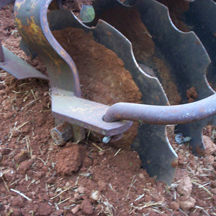More than you ever wanted to know about hay rakes....
This months Progressive Farmer has a little two paragraph blurb about an Ohio State field test to see what if any effect, hay rake design has on drying efficiency and nutritional value. They tested what we call wheel rakes (they're called finger rakes in some parts of the country), bar rakes(this is the traditional type of rake where I live) and rotary rakes.
Bar rakes have been around for close to a hundred years now and are pretty much the most common type of rake here. Wheel rakes are not quite as old, but they are gaining in popularity primarily (in my opinion) because they are pretty inexpensive (you can get an 8 or 10 wheel V-rake for less than 4k), they're also popular because the V-rakes will make a windrow in one pass, instead of two passes with a bar rake. Rotary rakes are very uncommon around here. I have one neighbor that has one. He got it last year and loves it. He says it's the only rake he's ever had that can stay ahead of him when he's baling. (When he makes hay, he makes hay! He put up nearly 1500 tons of hay last year. I play at it compared to this guy)
I'm getting a bit sidetracked here...
The folks at Ohio State determined that rake type doesn't make any difference in drying time (there was a nutritional issue with alfalfa hay because of leaf loss, but that doesn't effect me since I'm out of the alfalfa business).
That may be true in Ohio, but I have to disagree with them as far as we're concerned down here. From what I've seen, wheel rakes help with drying in the humidity down here. They make a very loose, airy windrow (which is HARD to square bale behind) that lets the wind and sun get down into the windrow to help it dry out fast.
A bar rake can make a windrow like that if you're only raking one swath. If you double rake (rake two swathes together), which is what most folks around here do, it tends to rope the hay, which makes it feed into my square baler better, but it doesn't help with drying. In extremely thick hay, a bar rake will rope hay on a single pass. My PTO driven bar rakes (MF model 25's) are very bad about this. They make a very tight windrow, which is great for square baling, but only if the hay is dry enough to bale when I rake. It will not dry out in the windrow when I use the pickup rakes. My Hesston ground-driven rake isn't that bad about it, but bigger brother complains about my windrows when I rake with it. Last time he gripped about it, I told him to bale behind BP's (idiot neighbor) wheel rake with our baler, then come talk to me about my raking abilities.
I have never used a rotary rake, I've had several opportunities to buy one, but shied away from them, simply because I didn't know anyone who had any experience with one. After my neighbors success with his, I'm getting interested in one. One thing I noticed last year when they were in the field was the fact that the windrows were perfectly consistent throughout. No slugs, not thick spots and no roping. The problem is cost with a new one... I could buy a used tractor for the price of a new Kuhn rotary rake. I got way too many things that are a higher priority than that.





<< Home